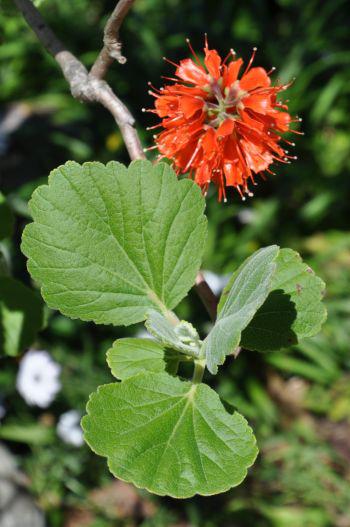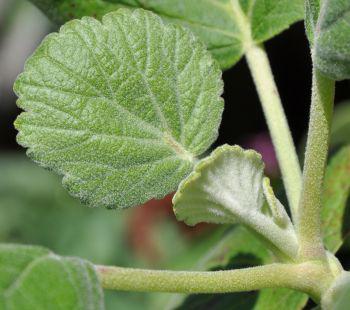Greyia radlkoferi
Greyia radlkoferi Szyszyl.
Family: Melianthaceae
Common names: woolly bottlebrush, Transvaal bottlebrush, wild bottlebrush (Eng.); wollerige baakhout (Afr.); isidwadwa (Zulu); inhlazane, indlebelembila (Swazi)
SA Tree No: 445
Introduction
The gnarled branches of Greyia radlkoferi make this small tree or shrub an attractive structural element for any garden. In nature, growing in misty gullies along rivers, its scarlet flowers stand out as if painted on the landscape. There are also white forms that are worth cultivating too.

Description
Description
Greyia radlkoferi is a large shrub or small tree, growing 2-4 up to 5 m in height. The branches have yellowish smooth bark when young, turning grey and deeply furrowed as the tree ages. The leaves are oval to heart-shaped, coarsely toothed and lobed at the base, sparsely hairy above and deeply woolly underneath, a characteristic that gives this tree its common name and distinguishes it from its more commonly planted cousin G. sutherlandii, the glossy bottlebrush. The petioles of G. radlkoferi are also very hairy and the longest of all three species.
The dense clusters of flowers are deep scarlet, blooming in upright racemes. The individual flowers are 20 mm long, with deep red stamens projecting from the mouth of the petal tube, which are slightly narrowed at the base. The 80 mm long racemes are borne at the end of the stems, before or with the new leaves, in winter to spring (July to October), which makes them all the more conspicuous. The cylindrical fruit capsules split open at one end to release seeds in the autumn.

Conservation Status
Status
Greyia radlkoferi is not threatened, and is assessed as Least Concern (LC) on the Red List of South African Plants.
Distribution and habitat
Distribution description
Greyia radlkoferi occurs mainly in the mist-belt mountains of Limpopo, Mpumalanga, in KwaZulu-Natal near Ngome and in Swaziland. It grows in deep channels along streambanks, bordering evergreen forest and among rocks.
Derivation of name and historical aspects
History
The genus Greyia is named after Sir George Grey (1812-1898), explorer and governor of South Australia, the Cape Colony and New Zealand. The species name is derived from Ludwig Radlkofer (1829-1927), Professor of Botany and Director of the Botanical Museum in Munich. The Swazi name inDlebelembila means 'dassie's ear'. The woolly undersides of the leaves gives this species its English and Afrikaans common names.

Uses
Use
Greyia radlkoferi wood is used to make household utensils and for carving handicrafts.
Growing Greyia radlkoferi
Grow
The plants are easy to grow from seed or cuttings. For best results take woody cuttings in spring and keep misted, but not damp. When sowing seed place them in a sunny location and keep moist. Both cuttings and seeds will root faster if they have bottom heat.
Prick out seedlings into trays or small packets in midsummer and leave them there for the remainder of the season. When the cold weather arrives the young plants will drop their leaves. Transplant to the garden the following spring. G. radlkoferi will grow at the coast but it won't flower as well, as this plant needs colder, drier winters to set bud. It does flower in Cape Town at Kirstenbosch, where it receives winter rain.
The open structure of the G. radlkoferi provides a dappled shade perfect for growing Agapanthus, Dietes or Tulbaghia.
This Greyia is susceptible to aphid infestations during its flowering and leafing out period.
References
- Coates Palgrave, M. 2002. Keith Coates Palgrave Trees of southern Africa , edn 3. Struik, Cape Town.
- Nichols, G. 1998. Lively up your garden. Farmer's Weekly 84: 68.
- Palmer, E. & Pitman, N. 1972. Trees of southern Africa, vol. 2. Balkema, Cape Town.
Credits
Paula de la Cruz
Kirstenbosch NBG
October 2004
updated September 2016
Plant Attributes:
Plant Type: Shrub, Tree
SA Distribution: KwaZulu-Natal, Limpopo, Mpumalanga
Soil type: Sandy, Loam
Flowering season: Spring, Winter
PH: Acid, Neutral
Flower colour: Red, White
Aspect: Full Sun, Morning Sun (Semi Shade), Afternoon Sun (Semi Shade)
Gardening skill: Average
Special Features:
Horticultural zones










Rate this article
Article well written and informative
Rate this plant
Is this an interesting plant?
Login to add your Comment
Back to topNot registered yet? Click here to register.